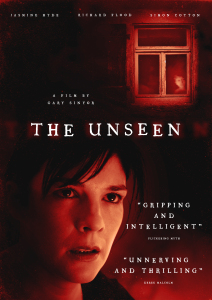When once referring to his first day on the job as a newspaper reporter, Samuel Fuller said, “I’ll always remember that moment as one of the most glorious rites of my life” (Fuller, A Third Face, 42). Although Fuller would become known as an accomplished screenwriter and director, for studios large and small, journalistic integrity remained at the core of his professional and private lives. Throughout his entire career, especially in the case of Park Row and The Madonna and the Dragon, Fuller poured every ounce of his newshound blood into his stories and characters. The “cut to the chase” system of front page delivery informed Fuller’s entire world view on storytelling. This, combined with his lifelong progressivism and his World War II experience, led to his constant humanization of outsiders in American society. Akin to filmmakers as acclaimed as Nicholas Ray or Stanley Kramer, Fuller injected social critiques and messages into his films that threatened to disrupt Hollywood’s social order. There are many films to which this applies, but three of his most popular films, Shock Corridor, The Naked Kiss, and White Dog, merit a particular study.
Coming off a long string of film noir, war pictures, and television projects, Fuller desired to make a film that embraced the craziness of the early sixties. He decided to adapt his script Straightjacket, which he had written in the early forties for Fritz Lang, into Shock Corridor in 1963 (402-403). The plot concerns Johnny Barrett, a journalist who subjects himself to entrance into a mental institution in order to solve a murder. Rather than simply escaping unscathed with the Pulitzer Prize, he succumbs to the hospital’s pandemonium and in the process loses his sanity. Fuller intended to expose pitiful conditions in mental institutions and asylums while exercising little subtlety in portraying racism, political ills, and sexual perversion (403). To do so, Fuller constructed realistic characters, sane and insane alike, particularly three witnesses to the murder under investigation: Stuart, Trent, and Boden. Two of these witnesses, Stuart and Trent, spotlighted American social issues, including communism and racism (406). To humanize these patients and others, Fuller and cinematographer Stanley Cortez utilized close ups, dolly shots, and swivel shots extensively, revealing that their internal struggles were just as rich as their external ones (412).

Stuart, a Korean war veteran and communist recruit, believes himself to be Confederate Civil War General J. E. B. Stuart, speaking only of battle plans that he constructs out of random objects and his home, the Old Dixie. When Johnny is finally able to ask him about the murder, Stuart is brought to reality by memories of Japan, which are depicted in color in the film by the addition of Fuller’s sojourns when visiting the country some years earlier. Stuart fondly recalls a large Buddha, children playing, and the specter of Mount Fuji, causing him to remember why he was so apt to join the communist cause in the first place. As he explains to Johnny, he was “fed bigotry for breakfast and ignorance for supper” when he was raised in the American South, and was given no sense of pride about his country, unlike what the Reds were able to offer him (Shock Corridor). Fuller humanizes Stuart here though close ups and nondiegetic music, allowing actor James Best to let the confusion that he has felt his entire life flow out through tears and dialogue. However effective his filmmaking may have been in its subtlety, Fuller’s frequent opines on communism garnered him countless accusations and even some investigations. He lashed back at these charges often, once saying, “My travels across America led me to believe that communism was a fantasy that would never supplant democracy among ordinary folk unless they were coerced” (Fuller, A Third Face, 82).
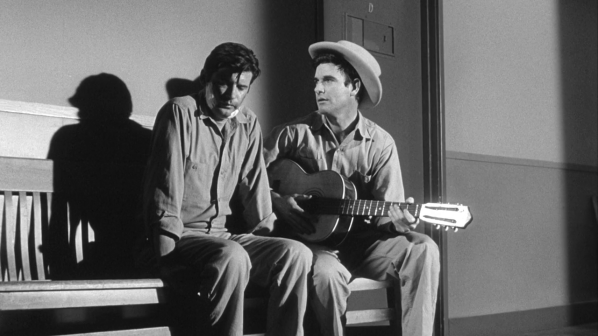
Trent was one of the first African American students to integrate into a Southern university, which led him down the path of insanity where he would become convinced that he was not only a member of the KKK, but that he created it. He often carries racist signs and dons pillowcases in the tradition of the organization. During his talk with Johnny, Trent becomes swept up in his racist rant, soon chasing a fellow black patient down the hall with many others in tow. As a result of the race riot, Trent and Johnny are confined to straightjackets, with which, along with the glass wall between them, Fuller creates an image of the unreconciled racial issues plaguing American society. The use of Fuller’s color footage of the Karaja tribe’s fertility dance within Trent’s dreams lends him a very raw fear.

Johnny and the other patients are depicted with temperaments that range from the mellow to the feverish. Johnny’s electro shock therapy and the methods of restraint used on patients are particularly gruesome to watch. Andrew Kötting highlighted this in his retrospective of the film, saying that he had tried to watch the film multiple times before total completion due to its very honest intensity (Kötting, 28). Overall, the film was a financial success, although Fuller saw little of it personally due to the unsound methods of producer Sam Firks (Fuller, A Third Face, 414). Nevertheless, the film stands as a testament to Fuller and both “his torment and a nation’s torment” (Kötting, 30).
As a journalist, Fuller frequented many brothels and learned very quickly to look upon the ladies there as nothing more than businesswomen (Fuller, A Third Face, 415). As he told Robert Porfirio and James Ursini, “Being a hooker does not mean being evil. The same with a pickpocket, or even a thief. You do what you do out of necessity” (Porfirio, et al.). These experiences led to his 1964 film noir The Naked Kiss, which tells the story of Kelly, a prostitute who attempts to start a new life in the picturesque suburb of Grantville after fleeing from her abusive pimp in the city. Although she takes great pains in becoming a nurse at a local children’s hospital and steering a fellow sex-worker out of the life, Kelly cannot escape her criminal past. Griff, one of Grantville’s finest, will not stop until she is publicly disgraced and forced out of town. Much to his chagrin, Kelly soon falls for Grant, the town’s own philanthropist, and pledges to marry him. When she finds out about Grant’s pedophilia, however, she brutally murders him and is jailed awaiting what is to be a very biased trial, as none of the townsfolk believe her.
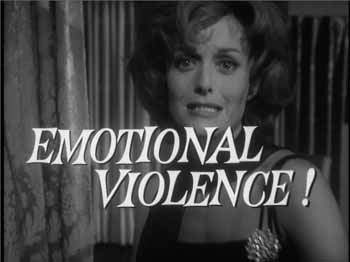

Fuller makes every effort to humanize Kelly throughout the film. During the opening scene, Kelly assaults her pimp for the money she is owed before leaving him for good. During the fight, her wig falls off and reveals a bald head, which the pimp had shaved as an act of control over her. Fuller attributes this to stories he heard about shamed women who had slept with Nazis during the war (Fuller, A Third Face, 421). During this sequence and the opening credits, Fuller and Cortez shoot Kelly in intimate close up, as well as utilize soft, high key lighting as she adjusts her wig back into place, giving her immense beauty and relatability. Kelly’s scenes with the handicapped children not only humanize her, but the children as well. Regarding Kelly’s involvement with the hospital, Fuller said, “She can love kids and be a good person and still go back to being a hooker without a second thought because that’s just business” (Porfirio, et al.). In one scene, Kelly encourages the children to believe that they are running, and Fuller shows us their imagination through a dissolve to a misty park where they run rapturously along with Kelly (Reeves). Later, Kelly has the children sing a song, during which Fuller frames close ups on each child as they sing their solo.
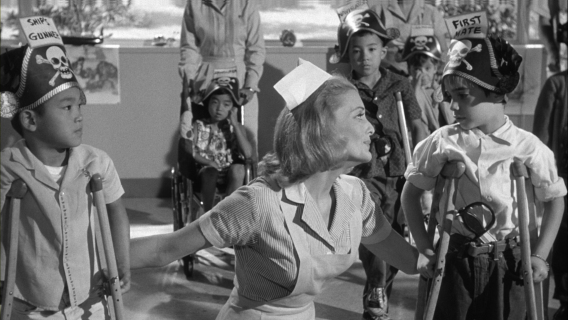
Fuller threatens to turn all this on its head, however, when Grant gives a soliloquy before he meets his gruesome fate. He attempts to appeal to Kelly after she finds him alone with a little girl, saying “Now you know why I could never marry a normal woman. That’s why I love you… you understand my sickness. You’ve been conditioned to people like me. You live in my world… and it will be an exciting world… My darling, our marriage will be a paradise because we’re both abnormal” (The Naked Kiss). Grant’s equality of his sexual perversion and Kelly’s previous career could clash with Fuller’s humanization, but as he explained to Porfirio and Ursini, “What I wanted was the whole concept of a caste system… a real sense among the social outcasts that there is something so vile, so low, that even they must scorn it” (Porfirio, et al.). Furthermore, as Adrian Reeves observes, “Fuller doesn’t allow passive viewing… he demands engagement” (Reeves). In The Naked Kiss, Fuller leaves no room for a middle ground. There is a very fine line of good and evil, and he fully believes that the audience is savvy enough to recognize the difference between the two.
White Dog both supports, and is in direct opposition with, Fuller’s constant humanization of the outsider. The film was based on the novel by Romain Gary, and was originally slated to be directed by Roman Polanski. Fuller came onto the film during pre-production and rewrote the screenplay with Curtis Hanson in ten days (Fuller, A Third Face, 486-487). White Dog follows Julie, a young actress in Hollywood who adopts a large white German Shepard after hitting it with her car. She soon learns of the dog’s aggressive nature, especially towards African Americans, and opts to get it cured by a black dog trainer, Keys. While humanizing African Americans throughout the film, Fuller more often takes the chance to demonize racists. Fuller’s longstanding hatred of racism can be traced back all the way to his days in print, particularly in the case of a KKK rally that he covered in the thirties (73). What appears here is a fuming, unmuzzled disgust for white supremacy and inequality rather than a push towards racial reconciliation.
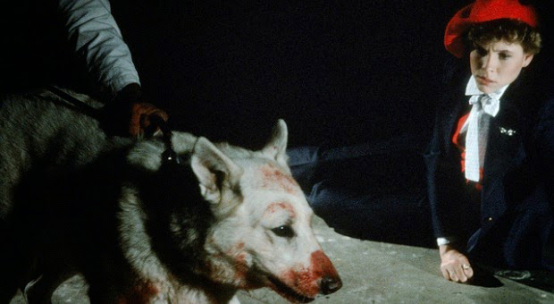
Fuller takes particular care in humanizing African Americans through Keys. As the film’s eponymous dog states in Fuller’s bizarre interview that he “conducted” for Framework, Keys is not portrayed as a “black scientist”, but as “a scientist. And that portrayal sets him apart from other characters played by blacks” (Fuller, “The White Dog Talks”, 24). Throughout the film, Keys is constantly determined to break the white dog, something he has been unable to accomplish in the past. His determination is one rarely depicted on film prior to Fuller’s. The scenes where the dog attacks are also worth noting, as one includes the murder of a black man in a church beneath a stained-glass window of St. Francis of Assisi. This, as Howard Hampton explained in Film Comment, “…mashed-up symbolism of lurid beauty, ironic religious iconography, and racial irrationality-animosity gets a special nauseous terror from its out of control quality” (Hampton, 48).

Running parallel to all this is Fuller’s demonization of the bigot, and to a certain extent, the dog. According to Hampton, “The dog seems like some primal force majeure that the liberal imagination fears it will never tame or expunge” (48). However, Fuller changed the dog from being trained to kill whites to being conditioned out of aggression altogether (Fuller, “The White Dog Talks”, 21). In the context of bigots, the film shows them very nakedly for what they are (23). The scene in which the owner comes to retrieve his dog from Julie is one of outright disdain. Fuller shoots the old man and his granddaughter in compromising close up, reversing one of his humanization techniques to peak effect. Despite all these efforts, before the film could be released, Paramount, the film’s distributor, decided to shelve the film due to rumors that the film was racist, when it was in fact the farthest thing from it. Fuller was furious about the rumors and their destructive result, going so far as to exile himself in France for over a decade (Fuller, A Third Face, 493).
As Samuel Fuller once said, he “depicted the little guy and his right to be different in movie after movie” (491). Shock Corridor, The Naked Kiss, and White Dog certainly proved that he was capable of not only producing a very entertaining yarn, but also being able to calculate answers to social issues that have still yet to be solved by the society at large. Fuller’s humanization may still be somewhat controversial today, but his determination has allowed him to remain in the filmmaking consciousness for over half a century. His progressivism paved the way for more bravery in expression in both the studio and independent systems respectively. There are few modern film pioneers as intense, engaging, and honest as him.
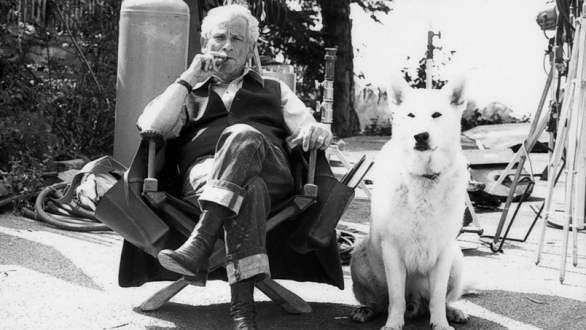
Works Cited
Fuller, Samuel. A Third Face, Applause, 2002.
Fuller, Samuel. “The White Dog Talks- To Sam Fuller.” Framework, vol. 1, no. 19, 1982, pp. 21-25.
Hampton, Howard. “Made for Each Other: Samuel Fuller vs. Robert Bresson.” Film Comment, Nov. 2009, pp. 44-49.
Kötting, Andrew. “My Noir: Shock Corridor.” Film International (Sweden), vol. 11, no. 5, 2013, pp. 28-30.
The Naked Kiss. Directed by Samuel Fuller, performances by Constance Towers, Anthony Eisley, Michael Dante, Allied Artists Pictures Corporation, 1964.
Porfirio, Robert, et al. “Samuel Fuller: About Film Noir.” Images: A Journal of Film and Popular Culture, vol. 1, no. 10, 2001.
Reeves, Adrian. “The Naked Kiss.” Cinematheque Annotations on Film, vol. 1, Issue 42, Feb. 2007.
Shock Corridor. Directed by Samuel Fuller, performances by Peter Breck and Constance Towers, Allied Artists Pictures Corporation, 1963.
Advertisements Share this:
